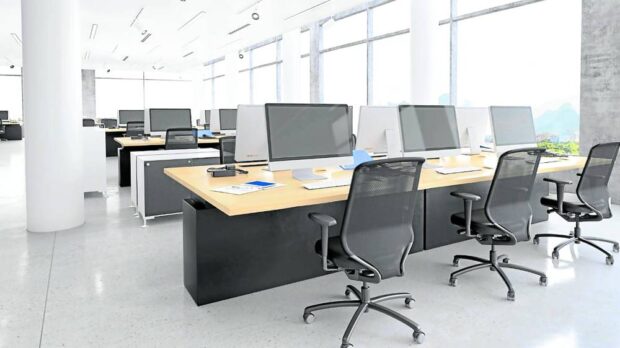(FILE PHOTO)
Demand for office space in the Philippines—one of the very few markets in the world that’s still expanding amid a challenging global economic environment—may end this year with a postpandemic high volume of 1 million square meters (sq m), Leechiu Property Consultants said.
In the first nine months, total office demand reached 809,000 sq m, up 17 percent from the same period last year and not too far from the 2022 total of 989,000 sq m, driven by the robust information-technology/business process management (IT-BPM) sector, said LPC director for commercial leasing Mikko Barranda.
“From experience and documents from our side, we should be able to surpass 2022 numbers. There’s a chance that we should hit a million square meter before the end of the year,” he said in a press briefing last week.
The projected volume by year-end is still below the all-time high levels seen in 2018 and 2019 amounting to 1.3 million and 1.7 million sq m, respectively, but Barranda noted that those were the years of the Philippine offshore gaming operators (Pogo) boom.
This year’s numbers, however, reflect “little influence” from Pogos given the recent tightening of local regulations and the snowballing demand from lawmakers and some business groups to phase out this controversial sector. Money laundering concerns, along with China’s crackdown on online gambling, are among those cited by critics.
Pogo uncertainty
Pogo proponents, on the other hand, have warned that a total ban would cost the economy anywhere from 0.6 percent to 1 percent of gross domestic product. At its peak, Pogo locators accounted for as much as 10 to 15 percent of the portfolio of major office landlords. Pogo workers, mostly from mainland China, also rented residences and contributed to consumer spending sprees.
Overall, a return to record-high office demand level could be achievable by 2024 or 2025, Barranda said. “But we need IT-BPM that will drive demand, although a lot of them are working remotely,” he said.
IT-BPM companies accounted for 240,000 sq m of net positive demand in the first half of 2023. This made Metro Manila one of three locations in the world after Bengaluru (350,000 sq m) and Delhi (308,000 sq m) that showed strong take up during the period.
The bulk of contracts are for multiple sites, reflecting the growing preference for “microsites” amid the work-from-home trend. In the past, IT-BPM firms preferred to lease a large space in a single location.
“The trend for opening microsites or hub-and-spoke operations in office space located in non-core areas demonstrates the increasing potential for venturing out of Metro Manila to establish new sites in provincial areas,” Barranda said.
The company also noted that 37 percent of IT-BPM transactions, equivalent to 124,000 sqm, was mainly leased in Metro Cebu, Quezon City, and Clark, Pampanga.
IT-BPM firms are likely opening microsites or applying the hub-and-spoke strategy to allow their employees to work-near-home to maximize employee retention, the firm said.
The current office supply in the country stood at 18.1 million sqm, with 82 percent of the available space located in Metro Manila. Moreover, the overall vacancy rate remains elevated at 19 percent due to the completion of new office buildings.
In Metro Manila alone, the vacancy rate averaged 18 percent. BGC has the lowest vacancy rate at 9 percent while the Manila Bay and Alabang/Las Pinas areas posted the highest at 27 percent.
In the first nine months, 77 percent of total office demand came from Metro Manila. Outside the metropolis, Cebu took up the lion’s share of the volume amounting to 109,000 sqm.
Total office vacancy rate in the country is still high at 19 percent especially as this year alone, about 1.3 million sqm of new supply had come to the market, Barranda noted.
“We will see that vacancy dip starting 2024 when the supply also dramatically go down,” Barranda said.
But given the pipeline of new supply in the coming years and assuming a consistent 1-million sqm annual demand, Philippine office vacancy rate would start easing next year until hitting single-digit levels by 2027.
In the residential sector, nearly 20,000 units have been launched in the first nine months, mostly catering to the upper-middle and upscale markets.
Assuming that fourth quarter performance will be the same as last year, LPC expects new residential launches and sales take-up to end this year 66 percent and 17 percent higher than last year, “reflecting enhanced confidence from both developers and investors.”
In the third quarter alone, the volume of launches fell 11 percent as high consumer prices affected demand for big-ticket items while developers focused on selling their existing stock.
Denial of responsibility! My Droll is an automatic aggregator of Global media. In each content, the hyperlink to the primary source is specified. All trademarks belong to their rightful owners, and all materials to their authors. For any complaint, please reach us at – [email protected]. We will take necessary action within 24 hours.


